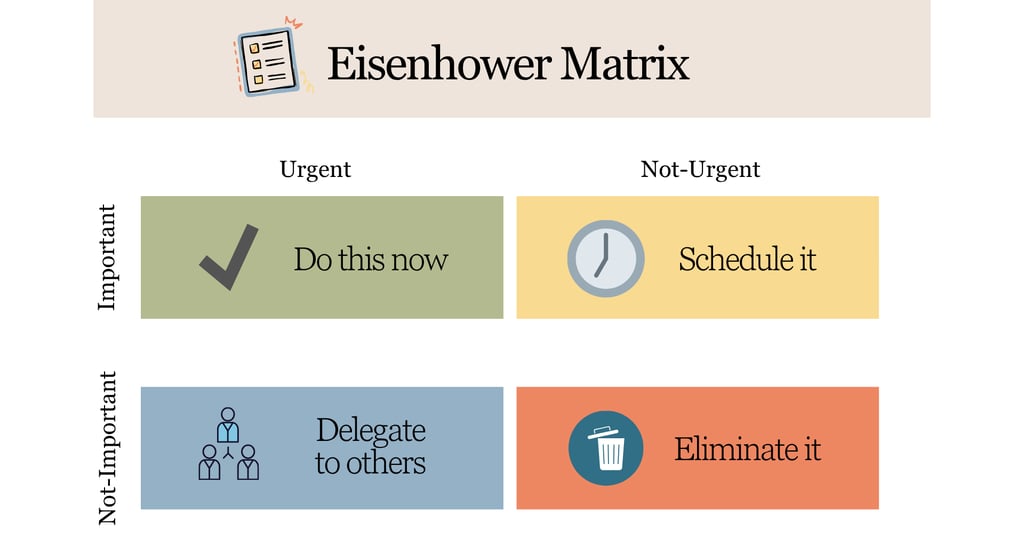Maximize Your Productivity: Effective Use of the Eisenhower Matrix
SELF HELPBUSINESSPRODUCTIVITY
7/21/20254 min read


If you’re someone for whom growth has always been a priority, and you want to maximize your productivity so that your time and energy are invested only in those tasks that move you closer to your short-term and long-term goals, then you must know about the Eisenhower Matrix, also known as the Urgent-Important Matrix.
I first came across this concept while reading Stephen Covey's The 7 Habits of Highly Effective People. Honestly, it’s one of the most powerful self-help books I’ve ever read. I’d highly recommend reading the whole book, but if nothing else, make sure you understand the Eisenhower Matrix—it’s a game-changer.
This matrix helps you divide your daily tasks into four quadrants, and what makes it powerful is how it gives you a clear sense of what to focus on, what to delay, what to delegate, and what to let go of entirely.


Quadrant 1: Important and Urgent
This is the “do it now” zone. These are tasks that are both important for your goals and urgent because they demand immediate attention. They’re typically deadline-driven or crisis situations.
Let me break it down with examples.
Suppose you’re studying medicine, and your dream is to become a successful doctor. If you have a final exam coming up in two days, then preparing for it is clearly a Quadrant 1 task. It’s urgent because of the deadline and important because it contributes directly to your career.
Similarly, if you’re a musician with a live performance or an important project deadline coming up tomorrow, you can’t ignore it. It’s urgent and important—it deserves top priority.
And sometimes, Quadrant 1 tasks are simple and survival-based. If someone is thirsty, the most important and urgent task in that moment is to find water. That becomes the top focus.
But here’s a warning—if your entire day is filled with only Quadrant 1 tasks, it’s often a sign that you’re not spending enough time in Quadrant 2, which we’ll talk about next.
Quadrant 2: Important but Not Urgent
Now, this is the quadrant that truly shapes your future.
These are tasks that are deeply important for your long-term goals but don’t require immediate action. And that’s why they’re so often ignored. But neglecting this quadrant is exactly why so many people feel stuck despite being “busy” all the time.
Let’s say your long-term goal is to become a great communicator. Quadrant 2 activities could be reading daily, journaling your thoughts, practicing speaking in front of a mirror or small groups. These don’t offer instant results, and they rarely feel “urgent,” but over time, they compound. And that compounding is what leads to mastery.
Another example: spending quality time with your loved ones. It might not be a pressing item on your to-do list, but it’s important for your emotional and mental well-being. In fact, science shows that such time releases oxytocin, a hormone that uplifts your mood and reduces stress.
Many people fall into the trap of doing only what's urgent while ignoring what's important. They justify skipping workouts, reading, learning, or resting—all of which fall into Quadrant 2—because they’re not “urgent.” But over time, this leads to burnout, disconnection, and lack of progress.
The secret to long-term success is to spend more time in this quadrant—scheduling these tasks and protecting that time like your future depends on it. Because it does.
Quadrant 3: Urgent but Not Important
This is where things start to get tricky.
These tasks feel urgent. Your phone is buzzing, emails are coming in, someone’s asking for help—they all demand your attention now. But here’s the catch: they’re not important to your goals.
For example, someone might call you to urgently review a document that you aren’t even responsible for. Or your inbox might be full of notifications that distract you from focused work. These tasks are urgent for someone else, not necessarily for you.
The best strategy here is delegation. If it’s something that needs to be done but doesn’t require your unique expertise or focus, let someone else handle it.
And sometimes, you just need to say no or set boundaries. You don’t need to be available for everyone, all the time.
Quadrant 4: Neither Urgent nor Important
Ah, the comfort zone. The guilty pleasures. The “I’ll just scroll for five minutes” zone.
This quadrant includes tasks that are neither helping you grow nor demanding immediate attention. Things like mindless social media scrolling, binge-watching without intention, gossiping, or checking your phone out of habit.
Now, let me be clear—rest and recreation are important. But they should be intentional, not default time-fillers. If you’ve taken care of tasks from the other three quadrants, and you choose to watch a show or scroll through reels to unwind—that’s okay. But if you’re in Quadrant 4 out of habit or procrastination, it’s a red flag.
This quadrant should ideally take up the least of your time.
The Eisenhower Matrix has helped me make smarter decisions with my time. It taught me to pause before reacting and ask: Is this really important? Is it urgent? Or am I just reacting?
Start small. At the beginning of your day or week, list your tasks and divide them into the four quadrants. It’s such a simple yet powerful shift that helps you stop being busy and start being purposeful.
Explore
Your go-to source for lifestyle, beauty, wisdom and travel.
Connect
Inspire
yellowoakleaf.info@gmail.com
